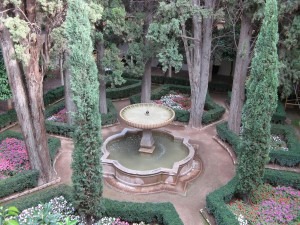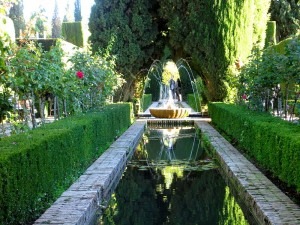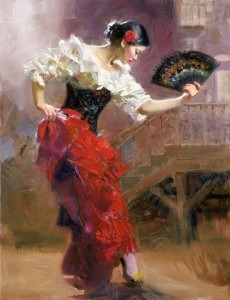
Gardens of the Generalife
The first movement depicts the gardens of the Generalife, near the Alhambra, in Granada, Andalusia, Spain.
Falla, Manuel de: Noches en los jardines de Espana (Nights in the Gardens of Spain): I. En el Generalife (In the Generalife) (Margaret Fingerhut, piano; London Symphony Orchestra; Geoffrey Simon, cond.)

The play of sun and shadow in the Generalife gardens
Falla not only succeeds in capturing the feeling of night in his music but if you exercise your imagination, you can catch the whiff of flowers, and a sense of the past with its ghosts and allusions of power.
The second movement, Danza lejana (Distant Dance), carries us to another kind of garden. This is a triple-time Allegretto in a dance where the garden is filled with people. There are activities going on all around us, and, in a distant corner, a dancer. It’s dramatic but not happy – we feel the dance is frenetic but that the dancer is filled with a feeling of tiredness and exhaustion.

Spanish dancers (artist unknown)
The second movement moves immediately into the final movement, En los jardines de la Sierra de Córdoba (In the Gardens of the Sierra de Cordoba). The Sierra de Córdoba (Mountains of Cordoba) refers to the Sierra Morena mountains that rise behind the city of Córdoba in Andalusia in southern Spain. We’re not in a formal garden as in Generalife but in a gypsy encampment in the mountains. We hear from the beginning the wild evocation of a festival and it’s definitely an evening gathering. Brilliant lights and dances appear in the music and we’ve moved into the wilds.
III. En los jardines de la Sierra de Córdoba (In the Gardens of the Sierra de Cordoba)
The work closes with a yearning for an infinite night. In this innovative work for piano and orchestra, Falla has transported us to the country he loved, and shows us Spain through its gardens, dances, and, by implication, its people and its history.
